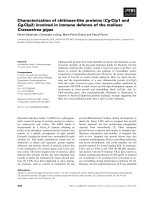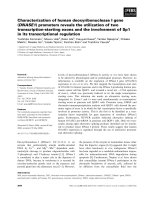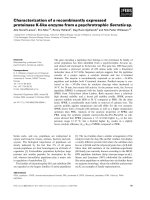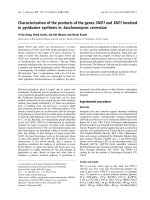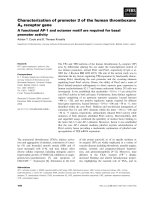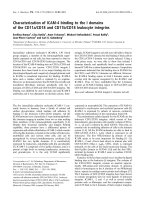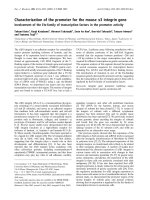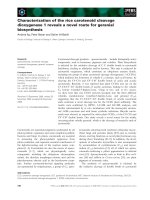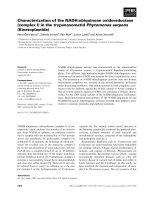Báo cáo khoa học: Characterization of the NADH:ubiquinone oxidoreductase (complex I) in the trypanosomatid Phytomonas serpens (Kinetoplastida) ppt
Bạn đang xem bản rút gọn của tài liệu. Xem và tải ngay bản đầy đủ của tài liệu tại đây (738.93 KB, 9 trang )
Characterization of the NADH:ubiquinone oxidoreductase
(complex I) in the trypanosomatid Phytomonas serpens
(Kinetoplastida)
Petra C
˘
erma
´
kova
´
1
, Zdene
˘
k Verner
2
, Petr Man
3
, Julius Lukes
ˇ
2
and Anton Horva
´
th
1
1 Department of Biochemistry, Faculty of Natural Sciences, Comenius University, Bratislava, Slovakia
2 Biology Centre, Institute of Parasitology, Czech Academy of Sciences, and Faculty of Biology, University of South Bohemia,
C
˘
eske
´
Bude
˘
jovice (Budweis), Czech Republic
3 Institute of Microbiology, Czech Academy of Sciences, Prague, Czech Republic
NADH:ubiquinone oxidoreductase (complex I) of the
respiratory chain catalyzes the transfer of an electron
pair from NADH to quinone, an oxidation reaction
that is coupled with the translocation of four protons
across the membrane. In prokaryotes, complex I is
composed of 14 subunits, the homologs of which con-
stitute the so-called core of the eukaryotic complex I
[1]. In the mitochondrion of some eukaryotes, this has
evolved into a complex formed of up to 45 different
subunits, thus becoming one of the largest membrane
protein complexes known [2]. Furthermore, complex I
contains a noncovalently bound flavin mononucleotide
and nine iron–sulfur clusters [3]. However, it can also
be reduced down to mere two subunits, as is the case
for complex I in the hydrogenosome of Trichomonas
vaginalis [4]. The recently solved crystal structure of
the bacterial complex [5] confirmed the predicted char-
acteristic L-shaped structure of both bacterial and
mitochondrial enzymes, composed of the hydrophobic
and hydrophilic arms [6,7].
Kinetoplastid flagellates such as Trypanosoma and
Leishmania are early-branching eukaryotes responsible
for sleeping sickness, Chagas disease, leishmaniases of
humans, and nagana of lifestock. Phytomonads are
trypanosomatids parasitizing various plants, causing
economically important diseases, such as wilts and
heartrot disease of coconut and oil palms and coffee in
Latin America and the Caribbean. In this study, we
have analyzed the function and composition of com-
plex I in Phytomonas serpens . The very presence of this
Keywords
complex I; NADH dehydrogenase;
Phytomonas; respiratory chain;
trypanosomatid
Correspondence
A. Horva
´
th, Department of Biochemistry,
Faculty of Natural Sciences, Comenius
University, Mlynska
´
dolina CH-1,
842 15 Bratislava, Slovakia
Fax: +421 260296452
Tel: +421 260296546
E-mail:
(Received 3 March 2007, revised 17 April
2007, accepted 25 April 2007)
doi:10.1111/j.1742-4658.2007.05847.x
NADH dehydrogenase activity was characterized in the mitochondrial
lysates of Phytomonas serpens, a trypanosomatid flagellate parasitizing
plants. Two different high molecular weight NADH dehydrogenases were
characterized by native PAGE and detected by direct in-gel activity stain-
ing. The association of NADH dehydrogenase activities with two distinct
multisubunit complexes was revealed in the second dimension performed
under denaturing conditions. One subunit present in both complexes cross-
reacted with the antibody against the 39 kDa subunit of bovine complex I.
Out of several subunits analyzed by MS, one contained a domain charac-
teristic for the LYR family subunit of the NADH:ubiquinone oxidoreduc-
tases. Spectrophotometric measurement of the NADH:ubiquinone 10 and
NADH:ferricyanide dehydrogenase activities revealed their different sensi-
tivities to rotenone, piericidin, and diphenyl iodonium.
Abbreviations
BN, blue native; CBB, Coomassie Brilliant Blue; DPI, diphenyl iodonium.
3150 FEBS Journal 274 (2007) 3150–3158 ª 2007 The Authors Journal compilation ª 2007 FEBS
complex in the model trypanosomatid Trypanosoma
brucei and related species is a matter of much debate.
Whereas several lines of evidence have proved the
presence of active respiratory complexes II–V, direct
detection of complex I has remained elusive. Argu-
ments for the existence of complex I in trypanosomat-
ids can be summarized as follows: (a) in Try. brucei,
mRNAs of putative mitochondrial-encoded subunits
undergo developmentally regulated RNA editing in
stages in which their presence would be appropriate
[8,9]; (b) homologs of several nuclear-encoded subunits
are present in the genomes of Try. cruzi, Try. brucei
and Leishmania tarentolae [10] (our unpublished
results); (c) antibodies against subunits of complex I of
other organisms detected putative homologs in the
mitochondrial lysates of Try. brucei [11,12] and P. ser-
pens [13]; and (d) in the mitochondrial lysates of
Try. brucei, NADH dehydrogenase activity has been
detected spectrophotometrically and by in-gel activity
staining [14], and found to be inhibited by rotenone, a
specific inhibitor of complex I [11,12]. However, seri-
ous doubt was cast over the latter evidence, as the con-
centrations of rotenone used were very high and may
have inhibited other electron carriers [15,16]. Another
line of evidence indirectly supporting the presence of
complex I in both procyclic and bloodstream stages of
Try. brucei comes from experiments showing constitu-
tive import of the nuclear-encoded subunit ndhK into
the mitochondrion [17].
The absence of complex I was originally reported
for procyclic Try. brucei [18], and later also for the cul-
ture forms of Try. cruzi [19], and laboratory-cultivated
strains of Crithidia fasciculata [20] and L. tarentolae
[21]. It has been proposed that complex I is missing, as
its activity was dispensable for cells cultivated in rich
media for a prolonged period of time [22]; this conclu-
sion was supported by the absence of translatable
mitochondrial mRNAs for complex I subunits [21].
Because complex I subunits in trypanosomatids have
only low sequence similarity with their putative homo-
logs in other eukaryotes, it was speculated that, in fact,
they may represent subunits of a complex that is rather
different from the typical eukaryotic complex I. The
detection of complex I in Try. brucei, using specific
inhibitors, is further hampered by the presence of
single-peptide alternative NADH dehydrogenases
[23,24], although the latest data indicate that only a
single alternative dehydrogenase exists in Try. brucei
(D. Beattie, personal communication). Moreover, an
alternative dehydrogenase was invoked to explain the
inhibitory effects of rotenone and atovaquone in
P. serpens [13]. Therefore, in the absence of direct evi-
dence, it has been unknown whether complex I is
present in kinetoplastid flagellates, and if it is, what its
functions are. Herein, we provide several lines of evi-
dence for the presence of complex I in P. serpens.
Results
NADH dehydrogenase activity in the mitochondrial
lysate of P. serpens was assayed by spectrophotometry
using two different electron acceptors and three inhibi-
tors. The employed electron acceptors were ubiqui-
none 10, an analog of natural ubiquinone that binds
to the region of the 49 kDa and PSST subunits [25],
and ferricyanide, for which binding to the hydrophilic
peripheral arm protruding into the matrix has been
predicted for bovine complex I [26]. Piericidin and
rotenone represent specific inhibitors of complex I
[27,28], whereas diphenyl iodonium (DPI) irreversibly
binds flavins, and was used for inhibition of the alter-
native NADH dehydrogenase [23,24,29]. We have tes-
ted the predicted specific inhibitory effect of DPI for
the single-peptide alternative NADH dehydrogenase
using the yeast Yarrowia lipolytica, in which its pres-
ence along with complex I has been well documented
[30]. Blue native (BN) 2–15% gradient gel electrophor-
esis and subsequent in-gel activity staining of the
mitochondrial lysate of Y. lipolytica confirmed that
DPI targets only the alternative enzyme (Fig. 1A).
AB
Fig. 1. In-gel staining of the NADH dehydrogenase activity in
Y. lipolytica (A) and P. serpens (B). Electrophoresis was performed
in 2–15% BN gradient gel. Lanes 1, 3, 5 and 7: BN gel photo-
graphed immediately after the run. Lanes 2, 4, 6 and 8: BN gel
after in-gel activity staining without (lanes 2 and 6) and with
(lanes 4 and 8) 100 l
M DPI. Arrows point to complexes with NADH
dehydrogenase activity. The size of the lower band with NADH de-
hydrogenase activity in lanes 2 and 4 corresponds to a dimer of the
alternative dehydrogenase of Y. lipolytica (molecular mass of mono-
mer is 67 kDa). The position of molecular mass markers is indica-
ted on the left (BSA and ferritin).
P. C
˘
erma
´
kova
´
et al. Complex I in Phytomonas serpens
FEBS Journal 274 (2007) 3150–3158 ª 2007 The Authors Journal compilation ª 2007 FEBS 3151
When the mitochondrial lysate of P. serpens was
resolved under the same conditions, a previously
reported [14] strong signal was visualized at about
650–700 kDa, and, unexpectedly, another specific and
even stronger band appeared higher up in the gel
(Fig. 1B, lane 6). A subsequent incubation of the gel
in DPI resulted in inhibition of the lower band only
(Fig. 1B, lane 8). On the basis of the size of multimers
of ferritin used as a molecular marker, the size of the
upper band was estimated to be about 2.2 MDa.
However, size inferred from electrophoretic migration
can be misleading, as multimerization frequently
occurs in the BN gels [22]. To assess this possibility in
P. serpens, we resorted to two-dimensional gel analysis,
with the first and second dimensions performed in a
2–15% gradient BN gel and a 10% denaturing gel,
respectively. A representative two-dimensional gel of
P. serpens aligned with the in-gel-stained first dimen-
sion for orientation is shown in Fig. 2. Several proteins
are visible in regions of the second dimension that cor-
respond to the activity bands in the BN gel. Five pro-
tein spots from the upper band, corresponding to the
high molecular mass region, were excised from a typ-
ical two-dimensional gel, in-gel digested with trypsin,
and subjected to MS analysis. Only the protein high-
lighted in Fig. 2 was clearly identified by the sequest
software (Fig. 3 shows an MS ⁄ MS spectrum identify-
ing the oligopeptide EQLFQYLLR). The six identified
peptides were matched to different regions of a single
hypothetical protein conceptually translated from
the L. major, Try. cruzi and Try. brucei genomes
(Fig. 4A). In order to increase the sequence coverage
of this hit and to identify proteins in the other spots,
we derived several partial amino acid sequences by
de novo sequencing. However, our attempts to match
these peptides using different blast algorithms to any
known sequence were unsuccessful.
This gene, highly conserved among trypanosomatids
and annotated as ‘hypothetical’, shows significant simi-
larity to members of the complex I LYR protein
Fig. 2. Mitochondrial lysate of P. serpens was resolved in two-
dimensional (2–15% gradient BN ⁄ 10% Tricine-SDS) gel and stained
with CBB. The positions of respiratory complexes I and V detected
by in-gel activity staining (shown only for complex I) are indicated
by Roman numerals. The sequenced subunit is shown by an ellip-
sis; arrows point to a unique subunit present only in the large form
of complex I. The position of molecular mass markers is indicated
on the left.
Fig. 3. MS ⁄ MS spectrum identifying the
oligopeptide EQLFQYLLR. Nearly complete
b-ion and y-ion series were found as indica-
ted by the ticks in the insert in the top right
corner.
Complex I in Phytomonas serpens P. C
˘
erma
´
kova
´
et al.
3152 FEBS Journal 274 (2007) 3150–3158 ª 2007 The Authors Journal compilation ª 2007 FEBS
family (accession number PF05347), and in particular
with subunit B14 of NADH:ubiquinone oxidoreductas-
es of several eukaryotes (Fig. 4B). This family includes
small subunits of complex I, for which the presence of
the LYR tripeptide in the N-terminal part is character-
istic. Interestingly, the size of the B14 subunit in most
eukaryotes is 15 kDa, whereas its predicted size in
trypanosomatids varies from 77 to 83 kDa, with the
P. serpens homolog also falling into this range, as
judged from its mobility (Fig. 2).
This analysis confirmed that in P. serpens, the two
activity bands are not agglomerates of a single subunit,
but rather have a multisubunit composition, and that
the larger band is most likely not a mere multimer of
the lower one. It has at least some unique subunits
that are absent from the lower band (Fig. 2; arrows).
Owing to the horizontal smear, however, the presence
of the B14 subunit in the lower band cannot be ascer-
tained at this point. A cross-reaction of the antibody
against the 39 kDa subunit of bovine complex I with
the P. serpens lysate has been described elsewhere [13].
Using the same antibody, we obtained a strong signal,
suggesting a specific reaction with the 39 kDa homolog
in P. serpens (Fig. 5A). Immunodetection of the target
complex I subunit in the two-dimensional gel clearly
revealed its presence in both the large ( 2.2 MDa)
and small ( 0.7 MDa) forms of the NADH dehy-
drogenase (Fig. 5B,C), confirming that these forms
share subunits.
Finally, we studied the direct inhibitory effects of
piericidin, rotenone and DPI on the NADH dehydroge-
nase activities in the mitochondrial lysate of P. serpens,
using ubiquinone 10 and ferricyanide as electron accep-
tors. Measurable NADH:ubiquinone 10 oxidoreductase
activity was about two times lower than the
NADH:ferricyanide electron transfer (Table 1).
Whereas 100 lm DPI inhibits about 50% of the NADH
dehydrogenase activity regardless of the electron accep-
tor, both 5 lm piericidin and 10 lm rotenone inhibit
almost half of the NADH:ubiquinone 10 oxidoreduc-
tase activity, but have essentially no effect on the
NADH:ferricyanide activity (Table 1). When 2 lm rote-
none was added to the lysate, the measured effect was
very similar to that obtained with 10 lm of the drug,
Fig. 4. Sequence analysis of the LYR family subunit of complex I in P. serpens. (A) Alignment of the identified sequences from P. serpens
with closely related sequences from Try. brucei (XP_827964), Try. cruzi (XP_812266) and L. major (CAJ07108). In the identified sequences
from P. serpens, L stands for Leu ⁄ Ile. All peptides fit into the central region of these proteins (all are annotated as hypothetical) and show a
very high degree of similarity. (B) Multiple alignment of selected members of the LYR protein family: Try. brucei (XP_827964), Try. cruzi
(XP_812266), L. major (CAJ07108), Xenopus laevis (AAH88949), Rattus norvegicus (XP_235518), Bos taurus (AAI02431) and Homo sapiens
(CAI19953). Fully conserved residues are highlighted in bold and indicated by ‘*’; ‘:’ and ‘.’ indicate conserved ‘strong’ and ‘weaker’ groups,
respectively, according to
CLUSTALX.
P. C
˘
erma
´
kova
´
et al. Complex I in Phytomonas serpens
FEBS Journal 274 (2007) 3150–3158 ª 2007 The Authors Journal compilation ª 2007 FEBS 3153
whereas a concentration of 50 lm appeared to block all
NADH dehydrogenase activities (data not shown).
Discussion
Despite the fact that some strains of Phytomonas repre-
sent economically important pathogens of cassava, cof-
fee plants, and coconut and oil palms, almost nothing is
known about the mitochondrial functions of these
flagellates other than that they lack respiratory
complexes III and IV [31,32]. However, this important
feature represents a practical advantage for studying
complex I in this trypanosomatid. The mitochondrial
membrane of Phytomonas is likely to have a less com-
plex protein content, and no interference of com-
plexes III and IV with activity measurements can occur.
Alternative NADH dehydrogenase mimics the activity
of complex I [23,24,33], and previous attempts to chro-
matographically separate these activities in P. serpens
were not convincing [13]. Therefore, we resorted to
another approach. As complex I has previously been
detected in the mitochondrial lysates of Try. brucei and
P. serpens by in-gel activity staining [14], we decided to
further explore this approach by combining it with gra-
dient BN ⁄ Tricine-SDS gel electrophoresis complemen-
ted with inhibition experiments. This approach allowed
the detection of an activity band migrating at
2.2 MDa in P. serpens, along with a previously des-
cribed lower band with mobility similar to that of the
putative complex I of procyclic Try. brucei [14]. Reso-
lution of the BN gel in the second dimension revealed a
multisubunit composition of the complexes in question.
Whereas both small and large complexes shared several
subunits, the large form seems to contain a number of
unique subunits. One of the subunits found in both
putative forms of P. serpens complex I is most likely a
homolog of the 39 kDa subunit of bovine complex I.
From all the sequenced subunits derived from the
activity band, only one protein showed an unambiguous
hit in the databases, namely with the B14 subunit of the
mammalian NADH dehydrogenase. Being much larger
than its homologs in other organisms, the B14 subunit
of trypanosomatids could reflect substantial differences
between complex I subunits in these primitive eukaryo-
tes and those outside of the Kinetoplastida. Such a
divergence occurred despite the fact that this subunit is
considered to be an ancestral eukaryotic core subunit,
situated at the basis of the peripheral arm within sub-
complex Ia [25]. This occurrence is not without preced-
ent, as highly divergent or even unique subunits
constitute other respiratory complexes in trypanosomat-
ids [34]. Finding this subunit together with a homolog of
the 39 kDa subunit further supports the notion that in
P. serpens the detected NADH dehydrogenase is a genu-
ine complex I, a conclusion that was indirectly suppor-
ted by rotenone and cross-reacting antibodies [13,35].
So far, in the studied flagellate, we have no direct evi-
dence for the predicted ability of complex I to shuttle
electrons across the mitochondrial membrane. However,
the lack of sensitivity of membrane potential to the
inhibitors of complex V and its sensitivity to rotenone
[35] strongly point towards such a role for complex I,
which is the only other complex that can uphold poten-
tial in the mitochondrion of this flagellate [32].
A
B
C
Fig. 5. Immunodetection in a 10%Tricine-SDS gel of the 39 kDa
subunit of eukaryotic complex I in the mitochondrial lysate of
P. serpens (A). The position of molecular mass markers is indicated
on the left. The immunopositive signal in a 2D 2–15% BN ⁄ 10% Tri-
cine-SDS gel (C) comigrates with the in-gel activity staining in a
2–15% BN gel (B).
Table 1. Specific NADH dehydrogenase activity of P. serpens and
its inhibition. NADH dehydrogenase activity was measured in the
mitochondrial lysates of P. serpens as described in Experimental
procedures. Two different electron acceptors and three inhibitors
were used. Medium values of 4–10 experiments, SD and average
percentages of inhibition are shown. One unit (U) of activity catalyz-
es the oxidation of 1 nmol NADHÆmin
)1
. Specific activity is calcula-
ted as UÆ(mg mitochondrial protein)
)1
.
Electron acceptor Inhibitor
Specific
activity
(UÆmg
)1
)
Average
inhibition
(%)
Ubiquinone 10 – 30 ± 10 0
5 l
M Piericidin 16 ± 4 48
10 l
M Rotenone 20 ± 3 35
100 l
M DPI 18 ± 2 41
Ferricyanide – 60 ± 17 0
5 l
M Piericidin 54 ± 18 9
10 l
M Rotenone 52 ± 12 11
100 l
M DPI 31 ± 5 49
Complex I in Phytomonas serpens P. C
˘
erma
´
kova
´
et al.
3154 FEBS Journal 274 (2007) 3150–3158 ª 2007 The Authors Journal compilation ª 2007 FEBS
Each of the drugs inhibited between 35% and 48%
of total electron flow from the NADH dehydrogenase
complex I to ubiquinone 10 in the P. serpens mito-
chondrial lysate. As rotenone and piericidin are speci-
fic inhibitors of complex I in eukaryotes, we assume
that they bind to the large form of the complex,
which contains a homolog of the B14 subunit of
mammalian complex I. The residual activity is most
likely provided by the alternative NADH dehydroge-
nase, which is known to be resistant to both inhibi-
tors [23,24,33]. Moreover, the putative small form of
complex I (subcomplex I) may be insensitive to these
drugs, as described for bovine complex I [36]. It
appears that two sources contribute 40% of the total
NADH dehydrogenase activity inhibited by DPI. On
the basis of the in-gel inhibition experiments, we pro-
pose that this drug inhibits both the alternative
NADH dehydrogenase, a well-documented target of
DPI [24,29], as also confirmed by our results with
Y. lipolytica, and the putative subcomplex I. The dis-
criminatory effect of DPI excluded the possibility that
the 2.2 MDa large complex is just an oligomer
of the small form. The different influences of DPI on
the two forms could be caused by its failure to access
the flavin cofactor in the large form of complex I,
whereas the cofactor remains accessible in the small
form. Indeed, to address this possibility, experiments
with prolonged preincubation time have been per-
formed, in which the partial DPI inhibition was also
observed in the large form (data not shown). How-
ever, the unlikely possibility that the large form is in
fact an NADH dehydrogenase lacking any flavins
cannot be excluded at this point.
The existence of two forms of complex I in P. serpens
could be a consequence of a partial split of complex I
during the isolation procedure into its membrane-bound
part and peripheral arm. This possibility is supported by
the fact that the relative intensity of the lower band var-
ies with the conditions under which the mitochondrial
lysate has been prepared (data not shown). In a less
likely scenario, both bands with NADH dehydrogenase
activity correspond to complexes that differ in their
subunit composition, coexist in P. serpens, and have
different functions.
Experimental procedures
Cultivation and isolation of mitochondria from
Y. lipolytica
The Y. lipolytica strain E129 (MatA lys11-33 ura3-302 leu2-
270 xpr2-322) was grown in YPD medium consisting of 1%
(w ⁄ v) yeast extract, 2% (w ⁄ v) peptone and 2% (w ⁄ v)
glucose for 24 h at 28 °C. The cells were harvested by cen-
trifugation (1000 g, 5 min, 4 °C, U-32R centrifuge; Boeco,
Hamburg, Germany; rotor type 1617) and washed twice
with cold, sterile water. The pellet was washed in 2 mL of
1.2 md-sorbitol, and resuspended in 10 mL of solution A
[0.5 md-sorbitol, 10 mm EDTA, pH 7.0, 50 mm Tris ⁄ HCl,
pH 7.4, 2% (v ⁄ v) 2-mercaptoethanol, 1 mgÆmL
)1
zymo-
lyase]. The mixture was gently shaken for 45 min at 37 °C,
and briefly vortexed before centrifugation (250 g, 10 min,
4 °C, U-32R centrifuge, rotor type 1617). The pellet was
resuspended in 10 mL of mito-washing buffer (0.5 md-sor-
bitol, 1 mm EDTA, pH 7.0, 50 mm Tris ⁄ HCl, pH 7.4),
vortexed again, and spun (250 g, 10 min, 4 °C, U-32R cen-
trifuge, rotor type 1617). Finally, the supernatant was cen-
trifuged (16 000 g, 10 min, 4 °C, U-32R, rotor type 1689L),
and the mitochondrial pellet was stored at ) 80 °C.
Cultivation and isolation of kinetoplasts
P. serpens strain 1G, originally isolated from its insect vec-
tor, was cultured in brain heart infusion medium with
10 lgÆmL
)1
hemin at 26 °C. The kinetoplast–mitochondrial
vesicles from 5 · 10
8
cells were isolated by hypotonic lysis
as described elsewhere [14]. Pelleted mitochondrial vesicles
were stored at ) 80 °C until further use.
NADH dehydrogenase activity assays
Kinetoplast–mitochondrial vesicles isolated from 5 · 10
8
cells were resuspended in 40 lLof1m aminocaproic
acid, and the addition of 10 lL of 10% dodecylmaltoside
was followed by 1 h of incubation at 4 °C. The lysate
was spun in a microcentrifuge (15 600 g, 10 min, 4 °C,
5414 centrifuge; Eppendorf, Hamburg, Germany; 12-place
fixed angle rotor), and the protein concentration was
determined by the Bradford assay. Next, the supernatant
was used to determine the NADH dehydrogenase activity
using two artificial electron acceptors: ubiquinone 10 and
ferricyanide. The NADH:ubiquinone 10 and NADH:
ferricyanide oxidoreductase activities were measured in a
1 mL cuvette containing NDH buffer (50 mm potassium
phosphate buffer, pH 7.5, 1 mm EDTA, 0.2 mm KCN),
5 lL of mitochondrial lysate, and 5 lLof20mm
NADH. After addition of 10 lLof2mm oxidized ubiq-
uinone 10 or 5 mm ferricyanide, the change in absorbance
at 340 nm was measured every 10 s for 3 min. A unit of
activity was defined as the amount of enzyme that cata-
lyzes the oxidation of 1 nmol NADHÆmin
)1
, assuming an
extinction coefficient of 6.2 mm
)1
Æcm
)1
[13]. Solutions of
the inhibitors were freshly prepared. Piericidin was dis-
solved in ethanol, rotenone in dimethylsulfoxide, and DPI
in methanol. Inhibitors were added to the assay mixture
immediately before the start of the reaction. Different
concentrations of rotenone were used, as indicated in
Results.
P. C
˘
erma
´
kova
´
et al. Complex I in Phytomonas serpens
FEBS Journal 274 (2007) 3150–3158 ª 2007 The Authors Journal compilation ª 2007 FEBS 3155
In-gel activity staining
One hundred micrograms of proteins from the mitochond-
rial lysate was mixed with 1.5 lL of CB solution [0.5 m
aminocaproic acid, 5% (w ⁄ v) Coomassie Brilliant Blue
(CBB) G-250], incubated for 10 min on ice, and run on
2–15% gradient BN gel. For the in-gel activity staining of
complex I, the gel was transferred to reaction buffer (0.1 m
Tris ⁄ HCl, pH 7.4, 0.14 mm NADH, 1 mgÆmL
)1
nitrotetra-
zolium blue chloride) immediately after the run and stained
by slow agitation overnight. In the case of inhibition, the gel
was incubated in reaction buffer with 100 lm DPI. The
enzymatic activity of complex I appears as a specific violet
precipitate. The gel was subsequently fixed in a mixture of
30% methanol and 10% acetic acid [37].
Two-dimensional gel electrophoresis and
western blot analysis
Analysis of respiratory complexes of purified mitochondria
was performed with two-dimensional BN ⁄ Tricine-SDS gel.
One hundred micrograms of mitochondrial lysate prepared
as described above was loaded per lane, analyzed on
2–15% gradient BN gel, and resolved in 10% Tricine-SDS
gel. After electrophoresis, the gel was stained with CBB.
The mitochondrial lysate was resolved in two-dimensional
BN ⁄ Tricine-SDS gel, blotted, and probed with a monoclo-
nal antibody raised against the 39 kDa subunit of bovine
NADH:ubiquinone oxidoreductase (1 : 250) (Molecular
Probes, Eugene, OR, USA) and secondary anti-mouse
serum (1 : 1000) (Sevapharma, Prague, Czech Republic).
Secondary antibodies coupled to horseradish peroxidase
were visualized according to the manufacturer’s protocol
using the ECL plus kit (Amersham Biosciences, Chalfont St
Giles, UK).
In-gel digestion and MS
CBB-stained spots were excised from the gel and subjected
to reduction by 20 mm Tris(2-carboxyethyl)phosphine in
50 mm Tris ⁄ HCl (pH 8.1) at 75 °C for 30 min. Reduced
cysteines were alkylated by incubation with 30 mm iodo-
acetamide at 37 °C for 40 min. Next, the gel pieces were
washed, dried in a SpeedVac concentrator (Savent Instru-
ments, Holbrook, NY, USA), and rehydrated with a solu-
tion of 50 mm ethylmorpholine acetate (pH 8.2), 10%
acetonitrile, and 0.1 lgÆlL
)1
trypsin (Roche, Mannheim,
Germany). Digestion was carried out overnight at 37 °C.
Peptides were extracted from the gel and analyzed by LC-
MS ⁄ MS. The tryptic peptides were loaded onto a capillary
column (0.10 · 100 mm) packed with 10 cm of reversed
phase resin (MAGIC C-18, 200 A
˚
,5lm; Michrom Bio-
Resources, Auburn, CA, USA) and resolved using a
gradient from 5% acetonitrile ⁄ 0.5% acetic acid to 35%
acetonitrile ⁄ 0.5% HOAc over 50 min. The eluting peptides
were directly analyzed with an ion trap mass spectrometer
(LCQ
DECA
; ThermoQuest, San Jose, CA, USA). Full-scan
spectra were recorded in positive mode over the mass range
350–1800 a.m.u. MS ⁄ MS data were automatically acquired
on the two most intense precursor ions in each full-scan
spectrum. Tandem mass spectra were interpreted manually
and with sequest software. For searches, the ‘no protease’
option was chosen, and potential (oxidation of Met) and
static (alkylation of Cys) modifications were enabled.
sequest results were processed according to the criteria
described elsewhere [38].
Acknowledgements
We thank Rob Benne (University of Amsterdam) and
Fred Opperdoes (De Duve Institute of Cellular Pathol-
ogy) for critical reading of the manuscript. This work
was supported by grants from the Grant Agency of
the Ministry of Education of the Slovak Republic
and the Slovak Academy of Sciences 1 ⁄ 3241 ⁄ 06 (to
A. Horva
´
th), and the Comenius University UK ⁄ 139 ⁄
2006 and UK/247/2007 (to P. C
˘
erma
´
kova
´
), the Grant
Agency of the Czech Academy of Sciences Z60220518,
the Grant Agency of the Czech Republic 204 ⁄ 06 ⁄ 1558
and the Ministry of Education 2B06129 and LC07032
(to J. Lukes
ˇ
).
References
1 Walker JE (1992) The NADH:ubiquinone oxidoreduc-
tase (complex I) of respiratory chains. Q Rev Biophys
25, 253–324.
2 Carroll J, Shannon RJ, Fearnley IM, Walker JE &
Hirst J (2002) Definition of the nuclear encoded protein
composition of bovine heart mitochondrial complex I.
Identification of two new subunits. J Biol Chem 277,
50311–50317.
3 Hinchliffe P & Sazanov LA (2005) Organization of
iron–sulfur clusters in respiratory complex I. Science
309, 771–774.
4 Hrdy´ I, Hirt RP, Dolezˇ al P, Bardon
˘
ova
´
L, Foster PG,
Tachezy J & Embley TM (2004) Trichomonas hydroge-
nosomes contain the NADH dehydrogenase module of
mitochondrial complex I. Nature 432, 618–622.
5 Sazanov LA & Hinchliffe P (2006) Structure of the
hydrophilic domain of respiratory complex I from Ther-
mus thermophilus. Science 311, 1430–1436.
6 Grigorieff N (1998) Three-dimensional structure of
bovine NADH:ubiquinone oxidoreductase (complex I)
at 22 A in ice. J Mol Biol 277, 1033–1046.
7 Peng G, Fritzsch G, Zickermann V, Schagger H,
Mentele R, Lottspeich F, Bostina M, Radermacher M,
Huber R, Stetter KO et al. (1993) Isolation, characteri-
zation and electron microscopic single particle analysis
Complex I in Phytomonas serpens P. C
˘
erma
´
kova
´
et al.
3156 FEBS Journal 274 (2007) 3150–3158 ª 2007 The Authors Journal compilation ª 2007 FEBS
of the NADH:ubiquinone oxidoreductase (complex I)
from the hyperthermophilic eubacterium Aquifex aeoli-
cus. Biochemistry 42, 3032–3039.
8 Koslowsky DJ, Bhat GJ, Perrolaz AR, Feagin JE &
Stuart K (1990) The MURF3 gene of T. brucei contains
multiple domains of extensive editing and is homologous
to a subunit of NADH dehydrogenase. Cell 62, 901–911.
9 Souza AE, Myler PJ & Stuart K (1992) Maxicircle
CR1 transcripts of Trypanosoma brucei are edited and
developmentally regulated and encode a putative iron–
sulfur protein homologous to an NADH dehydrogenase
subunit. Mol Cell Biol 12, 2100–2107.
10 Peterson GC, Souza AE & Parsons M (1993) Character-
ization of a Trypanosoma brucei nuclear gene encoding
a protein homologous to a subunit of bovine NADH:ubi-
quinone oxidoreductase (complex I). Mol Biochem Para-
sitol 58, 63–70.
11 Beattie DS & Howton MH (1996) The presence of
rotenone-sensitive NADH dehydrogenase in the long
slender bloodstream and the procyclic forms of Trypa-
nosoma brucei brucei. Eur J Biochem 241, 888–894.
12 Fang J, Wang Y & Beattie DS (2001) Isolation and char-
acterization of complex I, rotenone-sensitive NADH:ubi-
quinone oxidoreductase, from the procyclic forms of
Trypanosoma brucei. Eur J Biochem 268 , 3075–3082.
13 Gonzales-Halphen D & Maslov DA (2004) NADH-ubi-
quinone oxidoreductase activity in the kinetoplasts of
the plant trypanosomatid Phytomonas serpens. Parasitol
Res 92, 341–346.
14 Horva
´
th A, Hora
´
kova
´
E, Dunajc
˘
ı
´
kova
´
P, Verner Z,
Pravdova
´
E, S
ˇ
lapetova
´
I & Cuninkova
´
L’ & Lukes
ˇ
J
(2005) Downregulation of the nuclear-encoded subunits
of the complexes III and IV disrupts their respective
complexes but not complex I in procyclic Trypanosoma
brucei. Mol Microbiol 58, 116–130.
15 Christmas P & Turrens JF (2000) Separation of
NADH-fumarate reductase and succinate dehydrogen-
ase activities in Trypanosoma cruzi. FEMS Microbiol
Lett 183, 225–228.
16 Hernandez FR & Turrens JF (1998) Rotenone at high
concentrations inhibits NADH-fumarate reductase and
the mitochondrial respiratory chain of Trypanosoma
brucei and T. cruzi
. Mol Biochem Parasitol 93, 135–
137.
17 Bertrand KI & Hajduk SL (2000) Import of a constitu-
tively expressed protein into mitochondria from procyc-
lic and bloodstream forms of Trypanosoma brucei. Mol
Biochem Parasitol 106, 249–260.
18 Hill GC & Cross GA (1973) Cyanide-resistant respira-
tion and a branched cytochrome system in Kinetoplasti-
dae. Biochim Biophys Acta 305, 590–596.
19 Denicola-Seoane A, Rubbo H, Prodanov E & Turrens
JF (1992) Succinate-dependent metabolism in Trypano-
soma cruzi epimastigotes. Mol Biochem Parasitol 54,
43–50.
20 Sloof P, Arts GJ, van den Burg J, van der Spek H &
Benne R (1994) RNA editing in mitochondria of
cultured trypanosomatids: translatable mRNAs for
NADH-dehydrogenase subunits are missing. J Bioenerg
Biomembr 26, 193–203.
21 Thiemann OH, Maslov DA & Simpson L (1994) Dis-
ruption of RNA editing in Leishmania tarentolae by the
loss of minicircle-encoded guide RNA genes. EMBO J
13, 5689–5700.
22 Speijer D, Breek CK, Muijsers AO, Hartog AF, Berden
JA, Albracht SP, Samyn B, Van Beeumen J & Benne R
(1997) Characterization of the respiratory chain from
cultured Crithidia fasciculata. Mol Biochem Parasitol 85,
171–186.
23 Fang J & Beattie DS (2002) Rotenone-insensitive
NADH dehydrogenase is a potential source of superox-
ide in procyclic Trypanosoma brucei mitochondria. Mol
Biochem Parasitol 123, 135–142.
24 Fang J & Beattie DS (2003) Identification of a gene
encoding a 54 kDa alternative NADH dehydrogenase in
Trypanosoma brucei. Mol Biochem Parasitol 127, 73–77.
25 Brandt U (2006) Energy converting NADH:quinone ox-
idoreductase (complex I). Annu Rev Biochem 75, 69–92.
26 Vinogradov AD (1998) Catalytic properties of the mito-
chondrial NADH-ubiquinone oxidoreductase (complex
I) and the pseudo-reversible active ⁄ inactive enzyme
transition. Biochim Biophys Acta 1364, 169–185.
27 Gutman M, Singer TP, Beinert H & Casida JE (1970)
Reaction sites of rotenone, piericidin A, and amytal in
relation to the nonheme iron components of NADH
dehydrogenase. Proc Natl Acad Sci USA 65, 763–770.
28 Esposti MD (1998) Inhibitors of NADH-ubiquinone
reductase: an overview. Biochim Biophys Acta 1364,
222–235.
29 Biagini GA, Viriyavejakul P, O’Neill PM, Bray PG &
Ward SA (2006) Functional characterization and target
validation of alternative complex I of Plasmodium falci-
parum mitochondria. Antimicrob Agents Chemother 50,
1841–1851.
30 Kerscher SJ, Okun JG & Brandt U (1999) A single
external enzyme confers alternative NADH:ubiquinone
oxidoreductase activity in Yarrowia lipolytica. J Cell Sci
112, 2347–2354.
31 Maslov DA, Nawathean P & Scheel J (1999) Partial
kinetoplast-mitochondrial gene organization and expres-
sion in the respiratory deficient plant trypanosomatid
Phytomonas serpens. Mol Biochem Parasitol 99, 207–221.
32 Nawathean P & Maslov DA (2000) The absence of
genes for cytochrome c oxidase and reductase subunits
in maxicircle kinetoplast DNA of the respiration-defi-
cient plant trypanosomatid Phytomonas serpens. Curr
Genet 38, 95–103.
33 Kerscher SJ (2000) Diversity and origin of alternative
NADH:ubiquinone oxidoreductases. Biochim Biophys
Acta 1459, 274–283.
P. C
˘
erma
´
kova
´
et al. Complex I in Phytomonas serpens
FEBS Journal 274 (2007) 3150–3158 ª 2007 The Authors Journal compilation ª 2007 FEBS 3157
34 Maslov DA, Zı
´
kova
´
A, Kyselova
´
I & Lukes
ˇ
J (2002) A
putative novel nuclear-encoded subunit of the cyto-
chrome c oxidase complex In trypanosomatids. Mol
Biochem Parasitol 125, 113–125.
35 Moyses DN & Barrabin H (2004) Rotenone-sensitive
mitochondrial potential in Phytomonas serpens: electro-
phoretic Ca(2+) accumulation. Biochim Biophys Acta
1656, 96–103.
36 Finel M, Skehel JM, Albracht SP, Fearnley IM &
Walker JE (1992) Resolution of NADH:ubiquinone oxi-
doreductase from bovine heart mitochondria into two
subcomplexes, one of which contains the redox centers
of the enzyme. Biochemistry 31, 11425–11434.
37 Jung C, Higgins CM & Xu Z (2000) Measuring the
quantity and activity of mitochondrial electron trans-
port chain complexes in tissues of central nervous sys-
tem using blue native polyacrylamide gel electro-
phoresis. Anal Biochem 286, 214–223.
38 Man P, Nova
´
k P, Cebecauer M, Horvath O, Fis
ˇ
erova
´
A, Havlı
´
c
˘
ek V & Bezous
ˇ
ka K (2005) Mass spectrometric
analysis of the glycosphingolipid-enriched microdomains
of rat natural killer cells. Proteomics 5, 113–122.
Complex I in Phytomonas serpens P. C
˘
erma
´
kova
´
et al.
3158 FEBS Journal 274 (2007) 3150–3158 ª 2007 The Authors Journal compilation ª 2007 FEBS
